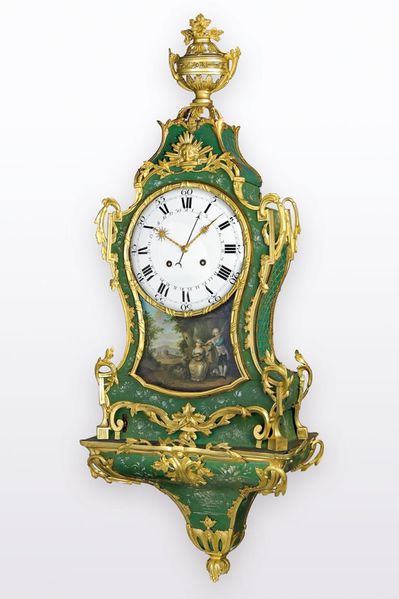Datei:Jan Hendrik Kuhn, Amsterdam, Werk Nr. 4140, circa 1770 (1).jpg

Originaldatei (570 × 856 Pixel, Dateigröße: 101 KB, MIME-Typ: image/jpeg)
Jan Hendrik Kuhn, Amsterdam / vermutlich Werkstatt Pierre Jaquet-Droz, La Chaux-de-Fonds, Werk Nr. 4140, Höhe 1140 mm, circa 1770

|
Alle Bildrechte liegen bei dem Auktionshaus Auktionen Dr. H. Crott. Diese Abbildung ist urheberrechtlich geschützt und steht nicht unter einer freien Lizenz. Für anderweitige Nutzungen außerhalb von Watch-Wiki ist die schriftliche Zustimmung des Urheberrechtsinhabers nötig. |
Prunkvolle, bedeutende Neuenburger Louis XVI Pendule mit Datumsanzeige, Halbstunden-/Stundenselbstschlag und phantastisch aufspielendem Flötenmusikspielwerk, stündlich auslösend sowie auf Anforderung, mit 6 Melodien sowie Figurenautomat für den holländischen Markt
Geh.: Holz, grünes Vernis Martin mit weißem Blütendekor und vergoldeten Bronzeappliken: Voluten, Blüten, Lorbeerranken und Akanthus, seitliche Schallöffnungen mit durchbrochen gearbeitetem Messingziergitter hinterlegt mit grüner Seide, gewalmter, profilierter Giebel mit appliziertem Apollohaupt und Vasenbekrönung, verglaste Fronttür und Rückseite, seitlicher Schnurzug zum Auslösen des Flötenmusikspielwerkes und des Automaten. Korrespondierende, geschwungene Wandkonsole. Ziffbl.: Email, radiale röm. Stunden, innerer Datumsring mit pfeilförmigem Zeiger, durchbrochen gearbeitete, vergoldete Sonnenstundenzeiger; vergoldete Lunette mit Lorbeerrankendekor. Kartuschenförmiges Zifferblattunterteil mit polychrom gemalten Automaten, Darstellung einer pastoralen Szene: analog zur Musik spielt eine Schäferin eine Laute. Zu ihrer Linken die statische Figur eines Jünglings mit Puderperücke und zeitgenössischer vornehmer Bekleidung beim Spielen einer Querflöte. Im Hintergund ein Gehöft. Werk: rechteckiges Messing-Vollplatinenwerk, profilierte Werkspfeiler, 2 Federhäuser, rückseitig aufgesetztes Rechenschlagwerk mit fein mattierten Stahlhebeln, Ankerhemmung, schweres Pendel mit Stahlpendelstange und Messinglinse. Musikspielwerk: schweres Messingwerk mit 2 x Kette/Schnecke und Fliehkraftbremse, darunter Messingrahmen mit hölzerner Stiftenwalze und 15 Metallflöten, rechteckige Signaturplakette.
A splendid and important Neuchâtel Louis XVI pendulum clock with date, half hour/hour strike and a marvellous flute playing musical movement with automaton and 6 tunes that activates on the hour and can also be activated manually, produced for the Dutch market Case: wood, green Vernis Martin decor with white flowers and gilt bronze appliques: volutes, flowers, laurel scrolls and acanthus. Lateral sound holes with open work brass grilles, green silk lining, moulded hip gable with applied head of Apollon and vase at the top. Glazed front door and back side, cord for releasing the automaton and the repeater that plays flute music. Matching curved bracket. Dial: enamel, radial Roman hours, inner date ring with arrow-shaped hand, open work gilt hand for the sun hours, gilt bezel with laurel scrolls. Cartouche-shaped lower part of the dial with painted polychrome automaton: pastoral scene with a shepherdess playing the lute along with the tune. To her left is a young man wearing a powdered wig and period costume, playing a German flute. Farm buildings are visible in the background. Movm.: rectangular brass full plate movement, moulded movement pillars, 2 barrels, on reverse side fine matted applied rack strike levers, lever escapement, heavy pendulum with steel pendulum rod and brass bob. Muscial movement: heavy brass movement with double chain/fusee and governor; a brass frame below with wooden pinned barrel and 15 metal flutes, rectangular signature panel.
Jan Hendrik Kuhn (1751-1810) German clockmaker Jan Hendrik Kuhn was born in Luebeck around 1751 and later worked as master clockmaker in Amsterdam. He had a workshop in Kalverstraat near the Heiligeweg from around 1786 until his death in 1810. The records show that Kuhn produced bracket and long case clocks as well as watches. Kuhn regularly advertised his long case clocks and in 1775 he advertised a musical long case clock that played on strings with a complicated automaton mechanism. Kuhn was a talented craftsman who specialized in the creation of long case clocks and the majority of them seem to have been equipped with complicated musical movements and automatons. The late 18th century was a period where there was a great interest in mechanical objets d’art with musical and moving parts and without doubt Kuhn must be regarded as one of the most important makers of his time. His workshop inventory of 1798 lists two longcase clocks with moving parts, one of them also has a musical movement.
Dateiversionen
Klicke auf einen Zeitpunkt, um diese Version zu laden.
| Version vom | Vorschaubild | Maße | Benutzer | Kommentar | |
|---|---|---|---|---|---|
| aktuell | 15:57, 15. Okt. 2014 |  | 570 × 856 (101 KB) | Andriessen (Diskussion | Beiträge) | Jan Hendrik Kuhn, Amsterdam / vermutlich Werkstatt Pierre Jaquet-Droz, La Chaux-de-Fonds, Werk Nr. 4140, Höhe 1140 mm, circa 1770 {{Bildrechte U|dem Auktionshaus Auktionen Dr. H. Crott}} Prunkvolle, bedeutende Neuenburger Louis XVI Pendule mit D… |
Du kannst diese Datei nicht überschreiben.
Dateiverwendung
Die folgende Seite verwendet diese Datei:
- Bildgalerie Uhrenmodelle Kuhn, Jan Hendrik
- Picture gallery watch models Kuhn, Jan Hendrik
- Galería de imagenes de modelos de relojes Kuhn, Jan Hendrik
- Afbeeldingen galerij uurwerkmodellen Kuhn, Jan Hendrik
- Фотогалерея Модели часов Kuhn, Jan Hendrik
- Galleria fotografica di modelli orologi Kuhn, Jan Hendrik
- Bildgalerie Uhrenmodelle Jaquet-Droz, Pierre
- Picture gallery watch models Jaquet-Droz, Pierre
- Galería de imagenes de modelos de relojes Jaquet-Droz, Pierre
- Afbeeldingen galerij uurwerkmodellen Jaquet-Droz, Pierre
- Фотогалерея Модели часов Jaquet-Droz, Pierre
- Galleria fotografica di modelli orologi Jaquet-Droz, Pierre